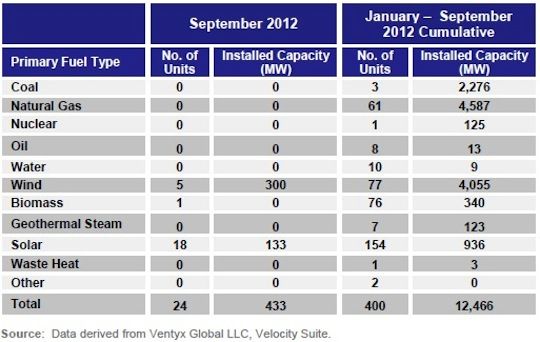The Document Diver of the Day Award goes to Kenneth Bossong, whose close reading of the Federal Energy Regulatory Commission’s September 2012 Energy Infrastructure Update [PDF] uncovered this tasty green morsel: Every megawatt of new electrical generating capacity installed in the United States in September was either wind or solar power.
Unfortunately, this doesn’t mean that coal and other dirty fuels (like natural gas, which, while better, isn’t clean) have packed up and gone home. Apparently, they just went on vacation in September, because in the preceding eight months, 4,587 megawatts of new natural gas capacity went into service, and coal came in with 2,276 megawatts.
image via Federal Energy Regulatory Commission
Still, that solar and wind swept the month is a sign of change -- and of more to come in the future if support for renewables is maintained, particularly on the wind front.
In September, five new wind projects, totaling 300 megawatts, went into service. That brought wind’s 2012 new-capacity total to 4,055 megawatts, ahead of last year’s January-September total of 3,239 megawatts, and it brought wind’s overall installed operating generating capacity to 51.07 gigawatts, which is 4.43 percent of total generating capacity.
The problem is, one of the big reasons wind is having a banner year is that developers are rushing to get their projects up and running before Jan. 1, 2013, because if they don’t, the projects won’t be eligible for investment tax credit or production tax credit. Under current law, both will expire when that giant ball comes down and the confetti flies in Times Square.
As for solar, that 133 megawatts figure was robust, representing more than 14 percent of the year-to-date’s 936 megawatts of solar -- and remember, we’re talking here about utility-scale projects only, not the thousands of distributed systems going up on residential and business rooftops all over the country. The biggest contributor was the Agua Caliente project in Arizona, where 50 new megawatts brought the plant total to 250 megawatts. It’s the biggest PV plant in the country, and by 2014 it will be up to 290 megawatts.
Such large-scale projects in the Southwest are becoming fairly commonplace under the Obama administration, but not all the sizable solar is happening in the desert. Here are some others that came on-line in September; they aren’t nearly as big as Agua Caliente, but each is impressive in its own way, as the FERC report notes:
- Zongyi Solar America’s 20-megawatt Tinton Falls Solar in Monmouth County, New Jersey, is on-line. Tinton Falls Solar is the largest photovoltaic project in New Jersey.
- Southern Sky Renewable Energy LLC’s 5.6-megawatt Canton Landfill Solar Project in Canton County, Massachusetts is on-line. This photovoltaic project is built on the closed and capped Canton Landfill. It is the largest solar facility in New England. The electricity generated is sold to the Town of Canton under a long-term agreement.
- SunEdison’s 3.6-megawatt Phase 2 Lakeland Regional Airport Solar Project expansion in Polk County, Florida is on-line. The Lakeland Regional Airport Solar has a total capacity of 6.3 megawatts. It is the largest photovoltaic project in Florida. The electricity generated is sold under long-term contract to Lakeland Department of Electric Water Utilities.
***
Editor's note: This article is reposted in its original form from EarthTechling. Author credit goes to Pete Danko.




